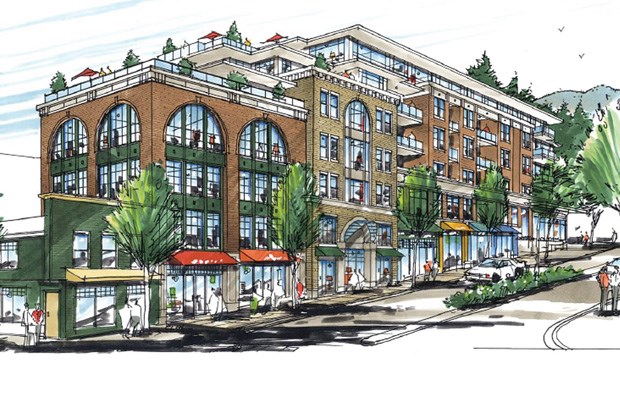After a public hearing Monday, City of North Vancouver council passed a bylaw rezoning the west side of the 100-block of Lower Lonsdale to allow for a six-storey mixed-use development.
The proposal includes 69 residential units, street-level retail, the preservation of an existing heritage building and office space.
It will also include five below-market living units for people with disabilities, a pedestrian mews and three levels of underground parking. Staburn Property Group, the developer, will make a $75,000 public art contribution.
The Beasley Block, home to Moodyville's cafe and part of the heritage restoration, is one of the oldest surviving buildings in the City of North Vancouver. "It's a very rare example of the boomtown-type commercial architecture," said Michael Epp, a city planner.
A 1904 photo of the original buildings served as inspiration for the proposed design, said Keith Hemphill, partner at Rositch Hemphill Architects. "We looked at those buildings to help us to define the kind of character that would go into it."
As the development moves up the hill from the heritage building, its facade is broken into large segments, he said. The concept implies that the building has grown up over time, as opposed to one brand new building, Hemphill said.
"As we get to the top of the hill, the building transitions into a much more contemporary look," he said.
The character of the proposed building has been well received by the public as well as advisory committees, Epp said, adding that the proposal meets the city's objectives of encouraging residential growth in the city centre, conserving heritage resources, and increasing the supply of office space and non-market housing.
The current zoning limits the height of the building to 40 feet, but the official community plan for the site allows for heights up to 60 feet, Epp said.
Staburn will receive density bonuses for employment-generating office space, the preservation and restoration of Beasley Block and affordable housing.
Although there was little opposition to the design of the building, some businesses are concerned about their future in the complex.
"The businesses that are affected by this development should know that if they wish to come back, they can come back," said Kerry Morris, speaking on behalf of Moodyville's cafe.
"We're asking if council can consider pushing Staburn to a more formal process where the businesses that are affected can, if they choose, come back," he said, noting that an oral statement is not enough.
Jeff Wren, a developer representative for Staburn, said that if an existing tenant is able to pay the market rate for the space, they will be given priority.
Pam Seale, a neighbour of the proposed complex in Lower Lonsdale, expressed concern over the impact of rooftop patios. "We know this is going to be very disruptive, especially because what's being pitched is six separate socializing areas that are going to be set up right outside our living spaces.
The beneficiaries are really the developer who can charge a bit more for those units and the individual that purchases the unit," she said.
Coun. Pam Bookham noted that it's ironic that council is granting additional density for employment generation as local businesses are forced from their affordable leased space and unlikely to return. "I'm concerned about the business community in Lower Lonsdale and I wonder if we're contributing to the problem by developing at the pace we're developing," she said.
However, higher residential density attracts more businesses, said Coun. Craig Keating. "Small businesses depend upon the fact that there is a vibrant residential neighbourhood," he said. "I think that in the long term, that balance between residential and commercial space will balance itself out.. .. It's not solving anybody's problems to keep the same crummy buildings that are there now."



